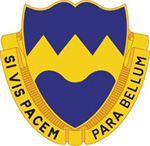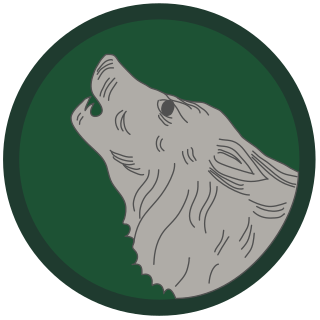
The 104th Infantry Division was an infantry division of the United States Army. Today, it is known as the 104th Training Division (Leader Training) and based at Fort Lewis, Washington, as a training unit of the United States Army Reserve.

The 84th Training Command ("Railsplitters") is a formation of the United States Army. During World War I it was designated the 84th Division, American Expeditionary Forces; during World War II it was known as the 84th Infantry Division. From 1946 to 1952, the division was a part of the United States Army Reserve as the 84th Airborne Division. In 1959, the division was reorganized and redesignated once more as the 84th Division. The division was headquartered in Milwaukee in command of over 4,100 soldiers divided into eight brigades—including an ROTC brigade—spread throughout seven states.

The 95th Infantry Division was an infantry division of the United States Army. Today it exists as the 95th Training Division, a component of the United States Army Reserve headquartered at Fort Sill, Oklahoma.

The 102nd Infantry Division ("Ozark") was a unit of the United States Army in World War II. The unit is currently active as the 102nd Training Division (Maneuver Support).

The 317th Infantry Regiment was a regiment of the United States Army during World War II. It was one of three infantry regiments in the 80th Infantry Division. Today, it is known as the 317th Regiment and is based in Lynchburg, Virginia as a training unit within the United States Army Reserve - currently under the 104th Training Division.

The 189th Infantry Brigade is an Infantry brigade of the United States Army based at Joint Base Lewis-McChord, Washington. It is a training brigade subordinate to First Army.

The 191st Infantry Brigade was constituted on 24 June 1921 in the Organized Reserves as Headquarters and Headquarters Company, 191st Infantry Brigade, and assigned to the 96th Division. It was organized in December 1921 at Portland, Oregon, and redesignated on 23 March 1925 as Headquarters and Headquarters Company, 191st Brigade, then redesignated on 24 August 1936 as Headquarters and Headquarters Company, 191st Infantry Brigade. It was converted and redesignated on 6 April 1942 as the 96th Reconnaissance Troop, 96th Division. The Troop was ordered into active military service on 15 August 1942 and reorganized at Camp Adair, Oregon, as the 96th Cavalry Reconnaissance Troop, an element of the 96th Infantry Division. It was reorganized and redesignated on 16 August 1943 as the 96th Reconnaissance Troop, Mechanized, and then again reorganized and redesignated on 20 November 1945 as the 96th Mechanized Cavalry Reconnaissance Troop. Following World War II service with the 96th Infantry Division in the Pacific, it was inactivated on 3 February 1946 at Camp Anza, California.
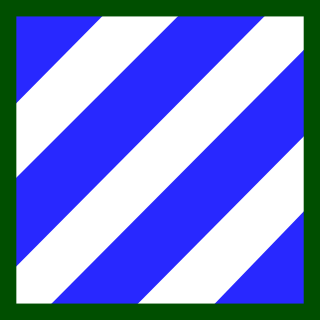
The 48th Infantry Brigade Combat Team is a modular infantry brigade of the Georgia Army National Guard. One of the oldest units in U.S. Army history, the lineage of the 48th Infantry Brigade can be traced back to 1825. It is one of few units in the US military that also saw service as a unit of the Confederate States of America during the American Civil War. Today, the 48th IBCT is part of the U.S. Army's "Associated Units" program where it's aligned under the 3rd Infantry Division, a combined arms combat maneuver unit of the Regular Army.
The 304th Infantry Regiment currently consists of two battalions in the United States Army Reserve. In the current organizational plan of the U.S. Army, regimental designation is used only in historical tradition; there is no regimental commander, staff or headquarters. The 1st Battalion, 304th Regiment is headquartered in Londonderry, New Hampshire, and the 3rd Battalion, 304th Regiment is headquartered in Saco, Maine.
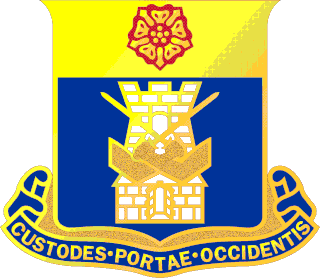
The 186th Infantry Regiment is a combat regiment of the United States Army made up of soldiers from the Oregon Army National Guard. The 1st battalion of the regiment is currently active. The 1/186th's higher headquarters is the 41st Infantry Brigade Combat Team, headquartered in Clackamas, Oregon. Its higher headquarters, in turn, is the 40th Infantry Division

The 2nd Brigade, 104th Division is an infantry brigade of the United States Army. It is a training component of the United States Army Reserve, and subordinate to the 104th Division based in Fort Lewis, Washington. It is primarily responsible for One Station Unit Training, Basic Combat Training and Military Police instruction.

The 3rd Brigade, 104th Division is an infantry brigade of the United States Army. It is a training component of the United States Army Reserve, and subordinate to the 104th Division based in Fort Lewis, Washington. It is primarily responsible for combat support training for soldiers entering the Military Police, Civil Affairs, Combat Engineering, Chemical Corps, and Signal Corps.

The 4th Brigade, 104th Division is an infantry brigade of the United States Army. It is a training component of the United States Army Reserve, and subordinate to the 104th Division based in Fort Lewis, Washington. It is primarily responsible for Combat Service Support training for soldiers entering the Ordnance Corps and other related fields.

The 108th Training Command (Initial Entry Training) is a United States Army Reserve unit headquartered in Charlotte, North Carolina. At its activation, the unit was designated as the 108th Airborne Division, but in 1952 was redesignated the 108th Infantry Division. In 1956, the division was again reorganized, this time to the designation as the 108th Division (Institutional Training). Under the U.S. Army Reserve Transformation of 2005, the 108th was reorganized to is current structure as the 108th Training Command (Initial Entry Training (IET)). The command is currently one of the largest in the Army Reserve, commanding and coordinating 9,000 soldiers.

The 86th Field Artillery Regiment is a inactive parent field artillery regiment of the United States Army, last represented in the Vermont Army National Guard by the 1st Battalion, 86th Field Artillery Regiment. Perpetuating the Vermont Light Artillery Batteries of the American Civil War and subsequent Vermont artillery units, the regiment was organized following World War II as the 206th Field Artillery Battalion in the Vermont National Guard. The 206th saw active service in Germany with the 43rd Infantry Division during the Korean War, and became the 124th Artillery, a Combat Arms Regimental System parent regiment, in 1959. Represented by the 1st Howitzer Battalion, 124th Artillery, the regiment was renumbered as the 86th Artillery in 1964 when the 1st Battalion became the brigade artillery battalion of the 86th Armored Brigade. The 1st Battalion served in that role with the brigade for much of the rest of its existence.
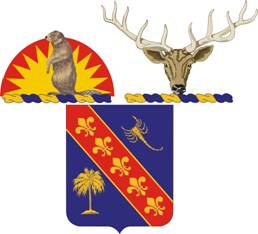
The 148th Field Artillery Regiment is a Field Artillery Branch regiment of the Army National Guard.
The 413th Regiment is a regiment of the United States Army Reserve. Established 24 June 1921 as the 413th Infantry, part of the Organized Reserves, it was attached to the 104th Infantry Division. The regiment was originally headquartered in Salt Lake City, Utah. Ordered into active service on 15 September 1942, the regiment saw service during World War II with campaign participation credit in Northern France, Rhineland, and Central Europe.
The 415th Regiment is a regiment of the United States Army Reserve.

The 358th Infantry Regiment is a unit of the United States Army. Organized in 1917, it took part in both World War I and World War II as a subordinate unit of the 90th Infantry Division.
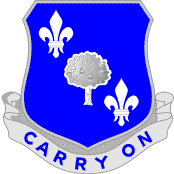
The 359th Infantry Regiment is a unit of the United States Army. It was active in Europe as part of the 90th Infantry Division during World War I and World War II, and components of the regiment were later part of the United States Army Reserve.

